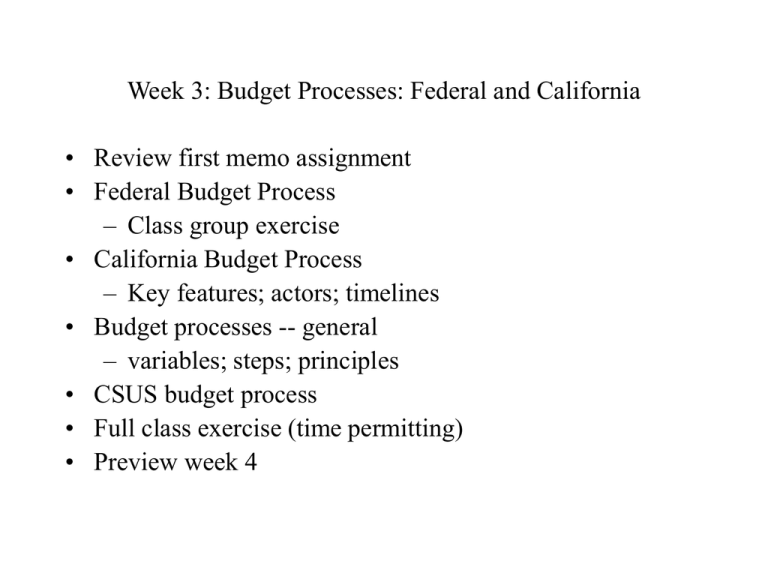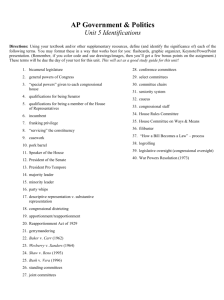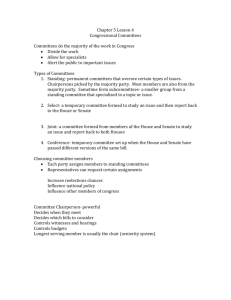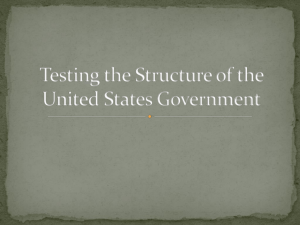Week 3
advertisement

Week 3: Budget Processes: Federal and California • Review first memo assignment • Federal Budget Process – Class group exercise • California Budget Process – Key features; actors; timelines • Budget processes -- general – variables; steps; principles • CSUS budget process • Full class exercise (time permitting) • Preview week 4 Characteristics of “A” Memo • Headings for each section of assignment, e.g. Budget Experience Expectations for PPA 230 Rubin Chapters • Bullets to make points (not necessary but often helpful) • Clear, concise, direct sentences – avoid inexact, “catch-all” phrases – well proof-read • Examples to make your points • Content of budget discussion not figured in this grade Key Characteristics of Federal Process • Competing frameworks: Congress v President • Dynamic: rules and norms change to meet the needs • Centrality of entitlements v. discretionary • Focus on deficit control • Multiple sets of congressional committees – Budget committees: Budget Resolution – Revenue committees (not annual process) – Authorizing committees (like policy committees) – Appropriations committees (13 separate bills) Key Characteristics, cont. • Fragmented • Decentralized – Different agency approaches – Bottom up or top down? • Public v hidden parts of process – Different degrees of politicization • Baseline driven – Implications of incrementalism Federal Process: Actors and Timelines • • • • • • President Office of Management and Budget (OMB) Executive agencies Congressional committees Congressional Budget Office (CBO) Timeline (about 18 months) – Initial preparation: March - June – Agency budget development: June - Sept – President’s budget development: Oct - Feb – Congressional Budget Resolution - April – Congressional review and appropriations - May-Sept – Fiscal year begins October 1 Class Exercise: the Federal Budget Process “The Federal Budget process is excessively complex and fragmented. The outcomes serve the individual interests of committee members and the collective interest of the political parties rather than the public interest of Americans. Since no regular citizen could understand the process, it does not serve the purpose of holding public officials accountable to the public, nor does it reflect public consensus on budgetary priorities. There must be a better way.” Do you agree? Why or why not? Key Features of State Process • Greater executive control than in Federal process • Budget balance requirement • Focus on agency programs and policy • One committee, one bill, one process in each house – Senate Budget and Fiscal Review – Assembly Budget – Appropriations committees no budget bill role • Trailer Bills • Governor’s Budget sets agenda for budget hearings • LAO gives item by item analysis (not done by CBO) • • • • • • State Budget Process: Actors and Timeline Governor Department of Finance (equivalent of federal OMB) Executive agencies Senate and Assembly budget committees/subcomm. Legislative Analyst’s Office (equivalent of federal CBO) Timeline (about 12 months) – – – – – – – – – Initial preparation: July-August Agency budget development (BCPs): Sept - Dec Governor’s Budget Presented: January 10 LAO Analysis published: mid-February Budget subcommittee hearings: February - May May Revise Conference Committee/”Big Five”: June Constitutional Deadline for Legislature: June 15 Start of fiscal year: July 1 State Legislature -- Budget Subcommittees Senate Assembly • Education • Education • Resources • Resources • Health and Human Services • Health • State Administration • General Government • Information Technology / Transportation • Energy Budget Process -- Variables • • • • • • • • • • organizational goals players rules/procedures documents timelines norms (request strategies) balance of executive/legislative power degree of centralization/coordination top-down/bottom-up openness to internal/external members Steps in a Budget Process • • • • • • • • • setting priorities (strategic planning) estimating revenues parameters and instructions for budget requests preparing requests reviewing requests constructing the budget defending the budget approving the budget distributing funds – micro decisions Principles of Effective Budget Processes • • • • • • • • • • • Process matches organizational culture – legitimacy Appropriate involvement of constituent groups Structured, annual budget process that is understood Plans and priorities drive budget Promotes priority setting and reallocation across budget Accountability for results Sufficient time to perform expected tasks Publish budget decisions Instruct managers in techniques of budget development Use budget to encourage desired results See CSUS budget memo Design a Budget Process for a School District Units: • 4 elementary schools • 2 middle schools • 1 high school Players: • superintendent/staff • school board • 7 principals • 7 PTAs Process Variables: • roles of various players • authority/balance of power • rules/procedure • documents/timelines • executive v legis power • degree of centralization • top down/bottom up • openness to internal • openness to external Preview of Week 4 • Thurmaier and Willoughby – did everyone pick up the chapter in class? – application of Kingdon to budgeting • Bland and Rubin Chapter 4 (not Rubin text!) • Guest Speaker from Dept of Finance • memo #2 due – you need to pick your department or agency!






